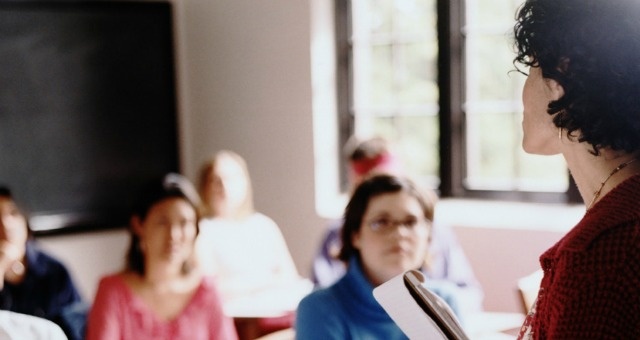 Professor Philip LaRocco is reimagining his Energy Business and Economic Development course with digitized lecture materials, collaborative assignments, and real-time feedback. With funding from Columbia University’s Office of the Provost, LaRocco teamed up with the Columbia Center for New Media Teaching and Learning (CCNMTL) to build a learning environment more conducive to the world in which his students currently intern, and plan to work in post-graduation. He is following a “flipped classroom” model—filming some of his lectures and making them available to students prior to class meetings—making way for more elaborate group review, discussions, and other collaborative assignments during class.
Professor Philip LaRocco is reimagining his Energy Business and Economic Development course with digitized lecture materials, collaborative assignments, and real-time feedback. With funding from Columbia University’s Office of the Provost, LaRocco teamed up with the Columbia Center for New Media Teaching and Learning (CCNMTL) to build a learning environment more conducive to the world in which his students currently intern, and plan to work in post-graduation. He is following a “flipped classroom” model—filming some of his lectures and making them available to students prior to class meetings—making way for more elaborate group review, discussions, and other collaborative assignments during class.
CURRENT ARTICLE • May 15
OTHER RECENT ARTICLES
An email query about teaching personas reminded me how much I haven’t figured out about our teaching identities. I’m still struggling with very basic questions and wondered if a conversation here might not get us all thinking more about how we present ourselves as teachers.
Read More › Inviting guest speakers into your classroom is a classic teaching strategy. Welcoming other voices into the classroom provides students with access to other perspectives, adds variety to the classroom routine, and demonstrates that learning is a collaborative enterprise. At the same time, however, presentations by guest experts are often plagued by a variety of design flaws that hinder their educational effectiveness. Guest experts, being unfamiliar with the mastery level of the students in the class, may speak over the heads of the students, or they may present their material at a level that is inappropriately introductory. Because they are generally unfamiliar with the class curriculum, they may repeat information that the students have already learned, or their comments may not connect in any clear way with what the students already know and what they are currently learning.
Inviting guest speakers into your classroom is a classic teaching strategy. Welcoming other voices into the classroom provides students with access to other perspectives, adds variety to the classroom routine, and demonstrates that learning is a collaborative enterprise. At the same time, however, presentations by guest experts are often plagued by a variety of design flaws that hinder their educational effectiveness. Guest experts, being unfamiliar with the mastery level of the students in the class, may speak over the heads of the students, or they may present their material at a level that is inappropriately introductory. Because they are generally unfamiliar with the class curriculum, they may repeat information that the students have already learned, or their comments may not connect in any clear way with what the students already know and what they are currently learning.
 In public speaking classes or classes where there are oral presentations, students often enter these environments with a bit of anxiety and trepidation about speaking in front of others. Providing in-class activities as early as possible in the semester, that allow students to share things about themselves in an informal and positive environment, can not only help contribute to their public speaking comfort level, it can also lead to community-building throughout the course. As the class progresses, students exhibit a greater likeliness to support each other, relax around each other, and even feel like they’re getting to know each other better.
In public speaking classes or classes where there are oral presentations, students often enter these environments with a bit of anxiety and trepidation about speaking in front of others. Providing in-class activities as early as possible in the semester, that allow students to share things about themselves in an informal and positive environment, can not only help contribute to their public speaking comfort level, it can also lead to community-building throughout the course. As the class progresses, students exhibit a greater likeliness to support each other, relax around each other, and even feel like they’re getting to know each other better.
A lot of students are in love with their highlighters, especially those bright, fluorescent-colored ones. They use them to highlight course materials, sometimes underlining whole pages of text. When I first saw a text so fluorescent that it all but glowed, I wondered why in the world somebody would spend that much time underlining. Later I understood it was really a cry for help. “I can’t tell what’s important, so I’ll just highlight the entire section so I don’t miss something.” Highlighting can be a useful way of interacting with text, but it needs to be done in a thoughtful way.
Read More ›We have all had the experience of having students sitting in our classes, looking directly at us, and knowing, just knowing, that they are not paying the least bit of attention to what we are talking about or what the topic of the day is. In fact, if we don’t see this in our classes (and I believe we all do…it’s just that some of us don’t wish to admit it), all an instructor has to do is review assignments, quizzes, or exams to find evidence that students don’t understand key concepts that were highlighted as “really important” or “critical” to understanding the material.
Read More ›For the first time since leaving graduate school almost 15 years ago, I enrolled in a class, “Maps and the Geospatial Revolution,” and the first day wasn’t like that of any other class I’ve taken. In lieu of finding a seat, I placed a virtual pin (labeled “participant”) on a digital world map, along with 47,000 of my classmates scattered around the world. I was enrolled in a MOOC.
Read More ›At this point in my career, I am expected to mentor others. It’s something I enjoy and it has never felt like an obligation. However, I haven’t given much thought to exactly what mentoring is, how best to do it, and why it’s a worthwhile endeavor. Mentoring is one of those higher education topics that was trendy for a while, but I no longer see it addressed much in current literature. That omission doesn't diminish its potential to greatly enhance both teaching and learning, and a revisit of the topic might remind us of its many values.
Read More › Upon setting foot in the classroom at the beginning of the semester, many students experience varying degrees of anxiety or fearfulness. As educators, we often sense nervousness among our pupils as we introduce ourselves and hand out copies of the course syllabus to review. Most students settle in shortly, but some may remain consistently fearful. Is it possible that their high levels of fear negatively affect their ability to learn in the classroom from week to week? In this article, we discuss the role of debilitating fear in some students’ lives and identify ways that educators can help them attain success despite their anxiety.
Upon setting foot in the classroom at the beginning of the semester, many students experience varying degrees of anxiety or fearfulness. As educators, we often sense nervousness among our pupils as we introduce ourselves and hand out copies of the course syllabus to review. Most students settle in shortly, but some may remain consistently fearful. Is it possible that their high levels of fear negatively affect their ability to learn in the classroom from week to week? In this article, we discuss the role of debilitating fear in some students’ lives and identify ways that educators can help them attain success despite their anxiety.
 Unfortunately, all too often performance on the first exam predicts performance throughout the course, especially for those students who do poorly on the first test. Faculty and institutions provide an array of supports for these students, including review sessions, time with tutors, more practice problems, and extra office hours, but it always seems it’s the students who are doing well who take advantage of these extra learning opportunities. How to help the students who need the help is a challenging proposition.
Unfortunately, all too often performance on the first exam predicts performance throughout the course, especially for those students who do poorly on the first test. Faculty and institutions provide an array of supports for these students, including review sessions, time with tutors, more practice problems, and extra office hours, but it always seems it’s the students who are doing well who take advantage of these extra learning opportunities. How to help the students who need the help is a challenging proposition.








